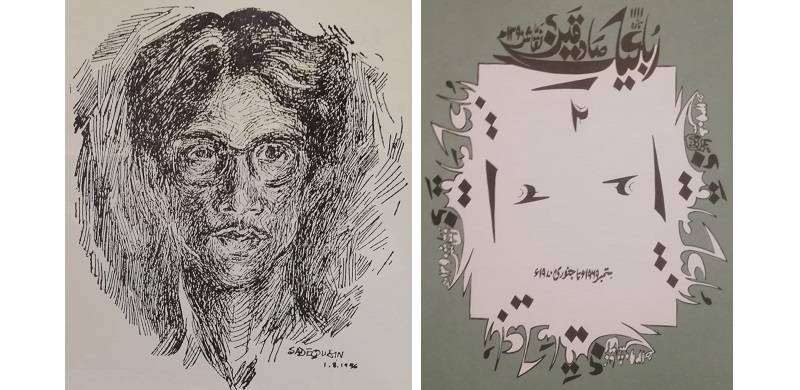
Rubā.ī (Rubaa’iyaat being its plural) is a genre that comprises four lines with the first, second and fourth lines possessing the same rhyming words. It is a formidable form of poetry where an entire subject is expressed in four lines only. There are numerous meters assigned for writing Rubā.ī. The themes expressed in a Rubā.ī are varied. And, composing it is a delicate and difficult art! It originated in Iran where the Persian bard Omar Khayyam made it famous and later it found a new dimension in Urdu poetry.
Many reputed poets tried their hands at the genre, but only a few became successful including, among others, Mir Anees, Mirza Dabeer, Shad Azimabadi, Yagana Changezi Azimabadi, Josh Malihabadi, Amjad Hyderabadi, Firaq Gorakhpuri, and Sadequain Amrohi.
Much has been written on the paintings of Sadequain, but his Rubaa’iyaat have been an unexplored subject so far and, therefore, considering this gap the present writer has attempted to showcase this aspect of the poet’s life.
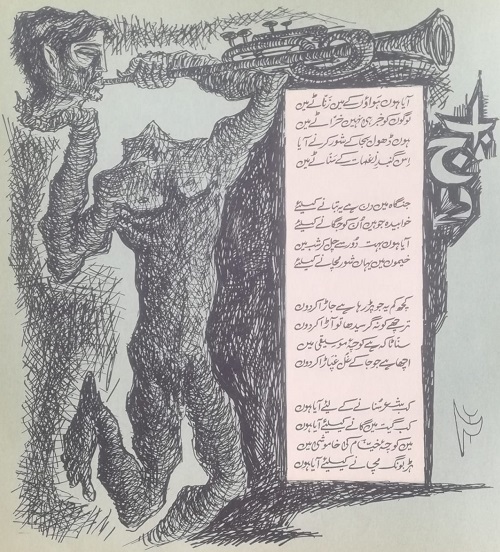
According to Sadequain (1930–87), he had always been clueless about the exact reason that led him to compose quatrains. But he opined that the answer to the conundrum was another question that inspired Urfi, the great poet, to paint.
Tasweer Mein Sahiri Ki Soojhi Kyon Thee
Urfi Ko Musavviri Ki Soojhi Kyon Thee
Kal Main Ne Kah Liye The Do Ek Misre
Kal Mujh Ko Bhi Shairi Ki Soojhi Kyon Thee?
He asserted that since infancy he was made to memorise Hamd, Naat, moral and elegiac quatrains that were aesthetically depicted on diaries or Bayaz. This habit inculcated in him an inclination towards poetry. As a result, he started composing quatrains at the age of 17. He retained a major chunk of such manuscripts while the remainder was lost and some were burnt by him.
On being asked as to why he chose Rubaa’iyaat instead of the Ghazal, he replied, “One of the legacies of my rich cultural heritage and background is the Rubaa’iyaat. In those times, moreover in small towns, the mode of decoration in the houses and Jamatkhanas was not paintings, but calligraphies of Rubaa’iyaat. They were the first shapes I saw in my childhood. And so, I used to write Rubaa’iyaat on takhtis. Another thing is that you can’t fit a Ghazal on a takhti because of its length and breadth, but a Rubā.ī fits in beautifully.”
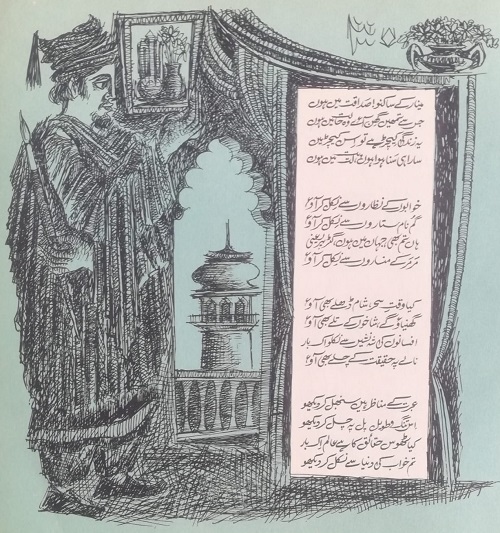 Sadequain emphasised that initially, the elders of his household were against his idea of dabbling in poetry. He said he was instructed not to try his hands at writing quatrains, as it required immense expertise in language and prosody, which would generally develop after the age of 40 years. Despite all these prohibitions, the painter continued to craft poetry.
Sadequain emphasised that initially, the elders of his household were against his idea of dabbling in poetry. He said he was instructed not to try his hands at writing quatrains, as it required immense expertise in language and prosody, which would generally develop after the age of 40 years. Despite all these prohibitions, the painter continued to craft poetry.Though Sadequain was not at home with Arabic, Persian and philosophy, he still excelled in composing the quatrains and by doing so he became an iconoclast who quashed the obsolete view that a writer of Rubā.ī must be well versed in the said subjects.
Sadequain considered Sarmad, the famous saint, as his spiritual master – who also dabbled in the art form.
His quatrains have attracted the gaze of other authors also, such as Faiz Ahmad Faiz, Dr. Nisar Ahmad Faruqi, Sibte Hassan and Khatir Ghaznavi who have written discursive essays on his poetry
Sadequain believed that being a trained poet had never been a prerequisite for writing Rubā.ī. He maintained that Sufi saints and rulers also composed Rubā.ī, though they were not bards per se. However, he never meant that he achieved their status by writing the quatrains. So, it could be assumed that Rubā.ī had always been independent of worldly constraints, and Sadequain considered it as a means to approach God.
He further paraphrased his aforesaid assertions by citing examples of Syed Abu Said Abul Khair (a Sufi saint), Omar Khayyam (an astronomer and mathematician), Bu Ali Seena (a philosopher), Babur (the Mughal emperor), Dara Shukoh (the Mughal prince), and Sarmad (a Sufi saint) – all of whom composed Rubaa’iyaat. According to Sadequain, almost all the Mughal emperors except Aurangzeb tried their hands at the Rubā.ī.
Sadequain announced that he had relished the Urdu Rubā.ī of all the poets without any distinction.
He had developed a unique mechanism of using certain letters in Rubā.ī which appeared eye-catching when transformed into calligraphic specimens.
Renowned research scholar Dr. Farman Fatehpuri has drawn similarities between the works of Omar Khayyam and Sadequain. He writes that had Sadequain been alive for some more years, he would have displayed his talents in other spheres of art also. And, to buttress his claim he quotes the following Rubā.ī of the painter.
Main Husn Ki Jis Anjuman-e-Naaz Mein Hun
Jo Kuch Bhi Hun Khud Apne Hi Andaaz Mein Hun
Khattat Ke, Shair Ke, Musavvir Ke Siwa
Main Aur Bahut Kuch Hun Magar Raaz Mein Hun
Dr. Fatehpuri adds that since Rubā.ī is composed of only four verses and must be delivered under certain meters, it is pretty tough to convey the desired messages. He writes that there could be numerous such meters, with slight variations, which are governed by the formidable rules of prosody and, hence, the poet should be adept with the technicalities to present his thoughts. Despite these odds, Sadequain emerged as an expert writer of Rubā.ī. His expertise in the language facilitated him to remain focused on the art form and, therefore, he produced a vast oeuvre of quatrains.
Malik Ram, another scholar of repute, has drawn parallels between the personalities of Sadequain and Ghalib. He cites the following Rubā.ī of Sadequain which delineates his wandering in Banaras – a city that had once hosted Ghalib when he was travelling to Calcutta.
Maikhane Mein Gahri Jo Wahan Raat Hui
Phir Shahr-e-Banaras Mein Ajab Baat Hui
Nikla Jo Kharabaat Se, Ghalib Se Meri
Ek Koo-e-Malamat Mein Mulaqaat Hui
Sadequain’s Rubaa’iyaat are the reflections of society and its different classes. But, collectively they are romantic in sense. Most of these were written at the instances of gorgeous women who adored him as a gentleman.
Kab Haibat-e-Do Jahan Pe Likhte Hum Hain
Kab Surat-e-La Makaan Pe Likhte Hum Hain
Ye Jo Hain, Rubaa’iyaan Hamari Ae Dost
Farmaish-e-Mahwashan Pe Likhte Hum Hain
Being a tool to gauge various social evils, Sadequain’s Rubaa’iyaat have classified the hypocrites into three broad classes which are anti-religious, anti-social and anti-intellectual. These Rubaa’iyaat successfully employ the tropes of monologue and antihero to convey their messages.
On being asked about the theme of his Rubaa’iyaat, he said, “It is a crusade against the hypocrisy, a declaration of war against hypocrisy. But yes, there is Ishq-o-Ashiqui too. When I was in Lahore, I drew a girl’s portrait, and she called me up the following day to ask what I had done after that. I told her I would call her up two minutes later. In those two minutes, I composed a Rubā.ī as an answer”.
Mukhre Ki Teri Tanweer Se Baatein Ki Theen
Zulf Ki Zanjeer Se Baatein Ki Theen
Kal Ek Teri Tasweer Bana Kar Maine
Phir Kuch Teri Tasweer Se Baatein Ki Theen
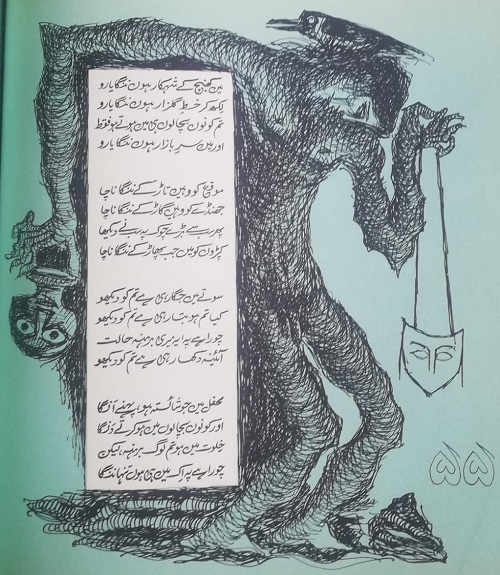 Sadequain considered himself a voice of the oppressed class and stressed that his Rubaa’iyaat and paintings represented the masses and their continuous struggle. This was the reason he usually called himself an artist of the gutter whose works should be reachable to the browbeaten society. He ensured that he never worked for places which were inaccessible to a common man and/or woman. He was wary of being called an artist of the swanky drawing rooms. He opined that the satiated face of an ordinary individual gave him more contentment and inspiration than the success of an entrepreneur.
Sadequain considered himself a voice of the oppressed class and stressed that his Rubaa’iyaat and paintings represented the masses and their continuous struggle. This was the reason he usually called himself an artist of the gutter whose works should be reachable to the browbeaten society. He ensured that he never worked for places which were inaccessible to a common man and/or woman. He was wary of being called an artist of the swanky drawing rooms. He opined that the satiated face of an ordinary individual gave him more contentment and inspiration than the success of an entrepreneur.He had had the habit of visiting hospitals and resting there for some days. One of the staff working in such a hospital was Ms. Lakshmi. She was dark-complexioned, talkative, and fond of chewing betel leaf which would leave her mouth red. She had a booming voice that would resonate in the surrounding. Sadequain called her Husn-e-Asvadii (the dark beauty).
Given her qualities, Sadequain had once composed the following Rubā.ī in her praise.
Go Peek Bahut Thook Rahi Hai Lakshmi
Khidmat Mein Kahan Chook Rahi Hai Lakshmi
Aspatal Ke Is Veerane Mein
Koyal Ki Tarah Kook Rahi Hai Lakshmi
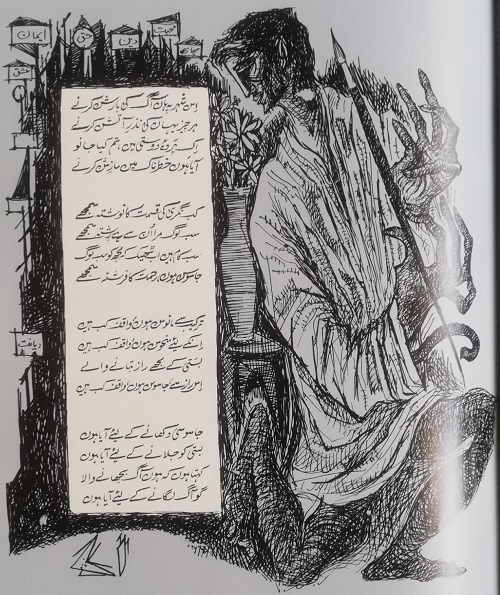 One fine day, a lady of an upper stratum of society, whom Sadequain disliked, visited him in the hospital. He gave her no attention, rather called Lakshmi to his room and requested her to pose for a portrait. Within minutes, Sadequain completed her portrait and told the other lady that common folk like Lakshmi always inspired him. She sensed the painter’s disenchantment towards her and the society she belonged to.
One fine day, a lady of an upper stratum of society, whom Sadequain disliked, visited him in the hospital. He gave her no attention, rather called Lakshmi to his room and requested her to pose for a portrait. Within minutes, Sadequain completed her portrait and told the other lady that common folk like Lakshmi always inspired him. She sensed the painter’s disenchantment towards her and the society she belonged to.Once, on the occasion of Diwali, Sadequain visited Lakshmi’s house, which was situated in a slum of Karachi, and greeted her. Such behaviour shows that he undeniably represented subjugated class and always preferred to blend with them.
Sadequain’s poetic genius was on a high between August 1969 and January 1970 when he composed numerous quatrains which formed a large portion of his tour de force book of Rubaa’iyaat. In February 1970, the poet transformed those verses into stunning specimens of calligraphy. Then he concluded his evolution as a bard in the following couplets which echoed the proverbial prohibition that a poet should not attempt at writing Rubā.ī until he reached 40.
Rutha Jo Jamaal Hai Manaya Main Ne
Ek Jashn-e-Visaal Manaya Main Ne
Is Umr-e-Azeez Ka Rubā.ī Kah Kar
Chaliswan Saal Hai Manaya Main Ne
In May 1970, the first edition of his Rubaa’iyaat got published in the form of a book, Rubaa’iyaat-e-Sadequain Naqqash. Its second edition, embellished with calligraphic sketches by the poet himself, hit the bookstores in September 1971. It was a rare occasion in the history of literature when a book carried poetry, calligraphy and relevant sketches by the same person.
Sadequain asserted that the idea of the second edition of Rubaa’iyaat struck him when he contemplated that the quatrains of Omar Khayyam were inscribed by Yaqoot and painted by Maani. He termed the said process as “Group Show” and attributed the below Rubā.ī to the practice.
Rangon Ki Hudud Mein Dikhaunga Wo Shai
Khakon ki Qayud Mein Dikhaunga Wo Shai
Jo Kuch Ke Adam Mein Dekhta Hun Main Aaj
Kal Tum Ko Wajud Mein Dikhaunga Wo Shai
When the second edition of his Rubaa’iyaat along with the pertinent sketches got accomplished, he concluded the course of action with the following lines.
Jab Paya-e-Takmeel Ko Pahuncha Kal Shaam
Dil Mein Ye Kaha Main Ne Utha Kar Ek Jaam
Mansoob, Mera Maah-e-Guzashta Ka Ye Kaam
Khaiyyam Ke, Yaqoot Ke, Maani Ke Hai Naam
His quatrains have attracted the gaze of other authors also, such as Faiz Ahmad Faiz, Dr. Nisar Ahmad Faruqi, Sibte Hassan and Khatir Ghaznavi who have written discursive essays on his poetry. Still, his Rubaa’iyaat, numbering up to 3,000, warrant extensive analysis by the legends, so that readers might appreciate the new vistas that the poet had opened using one of the toughest genres.
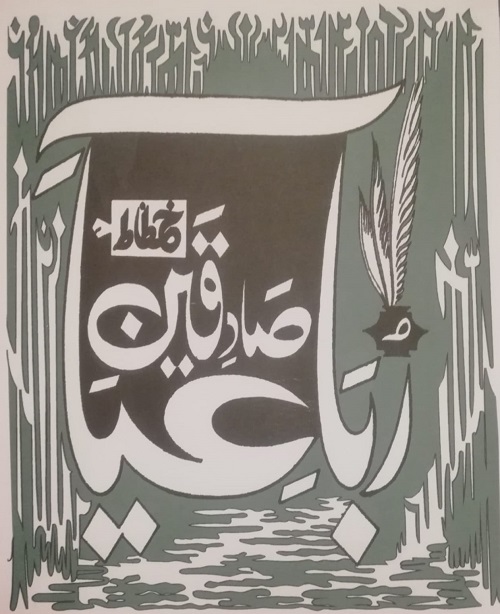
Being bohemian by nature, Sadequain never contemplated sincerely preserving and publishing his works, and this attitude harmed him in many ways. His admirers accumulated his works without even informing him. This is the reason why the global market is now flooded with his works, most of which are counterfeits. There are galleries and organisations in Lahore, Karachi, Islamabad, California, Dubai, and London which are thriving on such forged works, and minting money like anything. Despite being reprimanded time and again to put a brake, these galleries are selling forged Rubaa’iyaat, paintings and sketches and are quoting prices as high as 500,000 Indian Rupees. Therefore, in such an anarchic state of affairs, one should be thankful to all those real art connoisseurs who are busy preserving the true legacy of Sadequain.
To maintain the legacy of the poet, his Karachi-based real nephew and legal heir Syed Sultan Ahmed Naqvi accomplished a herculean task by publishing the magnum opus Kulliyat-e-Rubaa’iyaat-e-Sadequain in October 2009 which accommodated seven collections of his published and unpublished Rubaa’iyaat: Rubaa’iyaat-e-Sadequain Shair, Mutfareqaat, Rubaa’iyaat-e-Sadequain Naqqash, Rubaa’iyaat-e-Sadequain Naqqash (embellished with sketches), Rubaa’iyaat-e-Sadequain Khattat, Bayaz-e-Sadequaini and Juzv-e-Bosidah.

